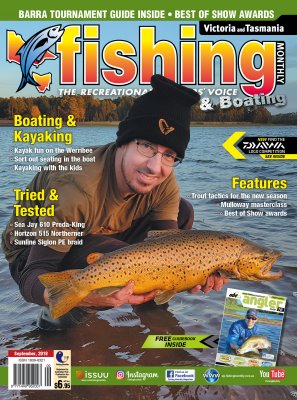Trout tactics for the start of the season by Jarrod Day
 Growing up in the foothills of the Dandenongs, fishing for trout was my weekly escape. It was even better with Monbulk Creek being only a kilometre from my driveway. Although it may be only a skinny water creek, it still delivers some impressive trout fishing throughout spring and it's not alone - there are hundreds more just like it all worth having a flick in with trout season now open.
Growing up in the foothills of the Dandenongs, fishing for trout was my weekly escape. It was even better with Monbulk Creek being only a kilometre from my driveway. Although it may be only a skinny water creek, it still delivers some impressive trout fishing throughout spring and it's not alone - there are hundreds more just like it all worth having a flick in with trout season now open.
Speaking of spring, we have finally reached that glorious time of the year. While saltwater anglers are chomping at the bit to chase snapper, for those inland anglers it's all about trout.
Trout fishing in Victoria has gone from strength to strength over recent years. Regular stocking programs have increased the trout populations in our rivers and while the season may close from the Queen's birthday weekend in June to 1 September, fishing for trout doesn't necessarily stop. There are plenty of lakes being regularly stocked.
Although it is nice to be hunting trophy trout in our lakes, flicking a softie or casting a fly to a wild brown or rainbow is something extremely special.
WHERE TO GO
Victorian streams are thriving with trout and it's sometimes hard to decide on where to head for opening weekend and thereafter. Too many choices can be confusing but it's really just a matter of picking one stream one day and trying another the next.
In the coming weeks, rivers such as the Goulburn, Stevenson, Acheron, Rubicon, Big, Howqua, Jamieson and the Delatite rivers are go-tos but there are hundreds of other smaller streams that don't become over crowded with anglers that are thriving with fish.
If you're close to Melbourne, the upper Yarra around McMahons Creek and Reefton is a great area to start. The river winds through some tough terrain and holds a very healthy population of trout, which can be caught on lures, fly and bait. There is good access from the roadside and it's just a matter of parking the car, getting out to fish a section and then moving onto the next.
If you're up for more of an adventure, further east you have a selection of the better rivers: Tanjil, Thompson, Tarago and Latrobe. Most of these wind through farmland and have great access for anglers. Most of the fish in these rivers are your typical stream trout averaging 300-400g and are willing lure takers.
To the west, rivers such as the Campaspe around Kyneton and Coliban are also well-known trout rivers. Even though they are small and shallow, they both have an extremely healthy population of brown and rainbow trout.
These are just a few of the more well-known rivers to make a cast into, but surrounding these there are myriad smaller creeks which also hold plenty of trout willing to take a lure.
TECHNIQUES
Fishing for trout, no matter what creek or river you fish, requires the same approach. Remember, trout face upstream to see what potential food is flowing down with the current. An angler walking with the flow will only spook the fish as they trundle through the water. It's imperative for success that you walk against the flow and cast well ahead of yourself to specific points. Even then, stumbling and splashing over the rocks and through the water will also spook them because of the noise. The best approach is to take your time, look and read the water and make plenty of casts.
If you're a lure flicker, flick the edges of the river to the snags. If the river has boulders or rocks sticking out of the surface then cast ahead of them bringing the lure through the current to pass by the eddy formed behind the rock; this is most likely where a trout will be waiting. Keep in mind; brown trout tend to favour an area with less current while rainbow trout tend to be found in the more turbulent water.
Most rivers are pretty much the same with fast runs leading into slow, deep pools. When working a pool, a deep diving lure worked around the edges is quite productive, but also don't be too shy to focus your energy where the fast water enters the pool. More often that not, there are a few trout loitering in these areas waiting for food to flow down. Casting up into the fast water and bringing your lure down is an effective technique.
If you're planning on bait fishing then you'll have to take a slightly different approach. Bait fishing methods can vary too. Firstly, you could have a bunch of garden worms rigged on a running sinker rig cast into the current to slowly flow down with the water's flow, while next you could be suspending a mudeye under a float and letting it slowly drift into the deep pools with the current.
Another effective bait fishing method is to use berley. This is done by rigging a small plastic or wire berley cage clipped onto a ledger boom, which your mainline is threaded through. The berley tends to be a mix of aniseed pollard stuffed into the berley cage, which also acts as the sinker. On the hook have a few gents (maggots) to float in the current. The trout pick up the smell of the berley and when they move in, devour the maggots.